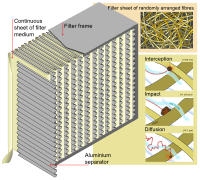
Photo from wikipedia
Fume hoods are an indispensable instrument for experimental operations dealing with hazardous chemicals, wherein safety operations are strictly adherent to regulations. Within this context, few cases exist wherein the ventilation… Click to show full abstract
Fume hoods are an indispensable instrument for experimental operations dealing with hazardous chemicals, wherein safety operations are strictly adherent to regulations. Within this context, few cases exist wherein the ventilation efficiency and pollutant capture efficiency inside fume hoods are precisely analyzed and quantitatively visualized. In this study, the pollutant capture efficiencies of a fume hood were analyzed by computational fluid dynamics as functions of exhaust airflow rate and according to the posture of workers in front of the fume hood. The indices for ventilation efficiencies, that is, age of air (SVE3), net escape velocity (NEV), and local purging flow rate (L-PFR), were adopted to quantitatively evaluate the pollutant concentration distributions formed inside the fume hood. NEV analysis revealed that the presence of a worker at the front of the fume hood did not significantly affect the pollutant capture efficiency at the opening surface of the fume hood. Changing the exhaust airflow rate resulted in changes in the size of the circulation flow formed in the upper part of the chamber. The circulation flow was found to have a dominant effect on the distribution of SVE3 and on the formation of the pollutant concentration distribution in the chamber.
Journal Title: Indoor and Built Environment
Year Published: 2022
Link to full text (if available)
Share on Social Media: Sign Up to like & get
recommendations!